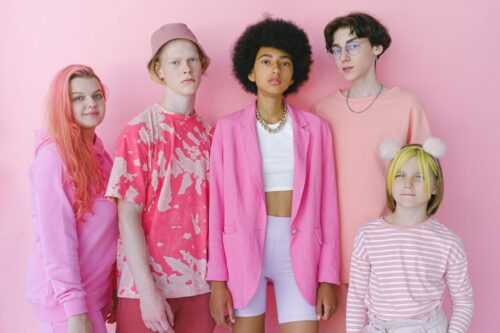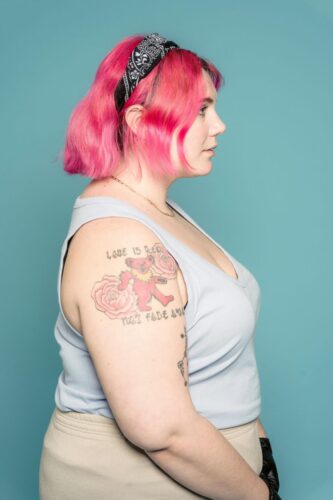Autism and Clothes: How to Be Fashion-Forward and Authentic Self

However, taking the time to discover an overall style tailored to your needs and preferences is extremely rewarding. Finding the right fabrics, haircuts, accessories, or even tattoos (there are even temporary ones so you don’t have to commit) or piercings, or whatever you choose that aligns with your identity can boost self-esteem.
Expressing your authentic self and showcasing being awesome can be transformative if you’re on the spectrum. It literally can make you feel more alive and accepted. Individuality with clothing – either expressed by being fashion-forward or choosing attire that makes a statement – promotes positivity and helps those of us in the autistic community to feel pride in celebrating our differences.
Figuring out my best look has been a challenge for me as an adult, as I have struggled (and still do) with comfort, convenience, and, to a degree, even caring. But, as I get older, I realize not only is there the importance of being comfortable in my skin but also knowing that how I present myself directly relates to my self-awareness and self-confidence.
I’ll also admit that, sadly, hygiene was an issue for me until the last few years. Thankfully, I’ve now got that figured out and practice good personal hygiene. It’s a struggle, however, for many on the spectrum throughout their lives.
READ MORE: Autism and Poor Hygiene – The Smelly Truth to Overcome
Here are tips for people with autism navigating the complex world of hair and fashion.
Autism and Clothes: Focus First on Comfort Before Choosing Fashion Forward
When beginning to develop your aesthetic, start by prioritizing comfort. Many people with autism experience sensory sensitivities that make certain textures, tightness of garments, or styling products used in hair overwhelming. You want to avoid fabrics that could cause skin irritation or general discomfort and lead to meltdowns.
Pay attention to which materials cause you issues – wool, corduroy, polyester, and scratchy lace are common culprits. Seek out soft, breathable fabrics like cotton, jersey, microfiber, silk or cashmere. When trying new clothes, check all labels for fabric content. Even better, look for tag-free designs or cut those scratchy labels out after you buy them.

You also want to opt for pieces that are easy to get on and off. Buttons, complex ties, and tiny zippers can be frustrating. Seek out pieces with elastic waists, oversized fits that slip right on, wrap styles, adjustable drawstrings, or large zippers. Tunics or asymmetric tops with leggings or harem pants or joggers allow comfort and movement. Dresses in soft knits are effortless one-piece outfits.
I really focus on comfort personally, and also on ease of wearability. Simply put, I prefer items without buttons and zippers altogether, although I realize they are good to have at times. I avoid blue jeans because of the zippers and buttons and don’t want to spend more time in the bathroom than I have to. I can also attribute my dislike of jeans to once having my zipper stuck, which put me in an embarrassing situation beyond my control.
I’d rather have loose-fitting items over skinny jeans or denim-anything, and I like pull-over shirts and pull-on athletic shorts. Since I live in Texas, that works for me for most of the year. When it does get too cold, a pair of fleece-style pants does the job.
For maximum comfort, I started observing my sensory symptoms and triggers and recommend others do the same. Make notes on which outfits cause anxiety so you can avoid those styles down the road. Reflect on when you feel the most relaxed and confident to identify the best garment silhouettes, necklines, and fabrics specifically for your needs.
RELATED: Autism Clothing for Sensitive Skin Can Enhance Quality of Life
You Choose You: Experiment with Layers for Expressing Your Authentic Self
Another key tip for autistic individuals developing a signature look is to embrace layering. Mixing and matching various tops, sweaters, vests, kimonos and lightweight jackets creates dimension in your outfit. Layering also provides extra insulation to deal with temperature sensitivity. You can easily remove pieces when feeling too warm or overwhelmed.
Build upon basics like t-shirts, tank tops, and shorts by topping them with open-front cardigans, long vests, flannels, or denim jackets. In cooler weather, go for a short-sleeved or sleeveless item with a coordinating sweater or jacket over top. Slouchy boho cardigans over your favorite tee and leggings or joggers achieve a perfectly curated messy chic vibe.
When layering, choose pieces in coordinating neutral solids, subtle prints, or matching color palettes so everything in your closet goes together seamlessly. It helps to start with more subdued hues on bottoms like black, navy, or grey leggings then experiment with bolder jewel tones, bright retro prints, or whimsical motifs on your lightweight layers.
Accessories can be like statement pieces. Adding colorful scarves, chunky jewelry, and bracelets or a big watch can instantly transform basics into fun statement outfits full of personality. Funky hats, sunglasses, earrings, and hair accessories are also easy statement-makers that allow you to switch up your style.
Consider a Flexible Hairstyle for Celebrating Our Differences
Along with clothing, finding the right hairstyle is pivotal in developing personal flair. However, frequently brushing long locks or keeping bangs trimmed can be difficult and irritating for many on the spectrum. When considering new haircut options, prioritize low-maintenance versatility.
Also, consider whether you want your hair to be kept away from the face and neck completely. They also require very little styling with the product. For those who prefer longer locks, look for layered medium-length cuts that sweep collarbones. This provides length to pull hair up or back while avoiding heaviness that drags on the skin.
I’m fighting hair in my face currently, as I am trying to grow out my hair. I’ve had the basic guy cut for almost all of my life, and am just trying something new as a way of “you choose you”. I’m also trying to use hair gel and blow it dry to keep it out of my eyes as well, which is a departure from my normal wash-and-go preference. We’ll see how it goes, but if I don’t like it, I’m just one hair appointment away.
Wavy or curly hair textures tend to have more natural volume at shorter lengths. Invest in a good smoothing conditioner or leave-in treatment to soften coarse curls that could be irritating. Also, consider hair dye or bleaching treatments to go fully expressive with bright fantasy hues. Use caution when doing chemical treatments at home and patch test skin first. Work with a trusted stylist knowledgeable on hair types to avoid damage.
No matter what length you choose, teach yourself easy fixes when having hair loose feels overwhelming. Explore options like fabric hair ties, textured clips, or soft headbands. Of course, there’s always the hat or ballcap option. Also, carry small travel brushes or combs to swiftly adjust styles throughout the day for relief.
Incorporate Fashion-Forward Special Interests That Show You Choose You

Whether you love gaming, anime, sci-fi, celebs, animals, or any other passionate fixation, find creative ways to work touches of that world into your everyday wearables and glam.
For example, if you adore Star Wars, Stranger Things, or retro 80s themes, show that love through t-shirt slogans, jewelry with character pendants, belts featuring iconic logos, or printed knee socks. Use other accessories like graphic watches, galaxy print sneakers, character hats, or badges on denim jackets to incorporate pop culture favorites.
Play with beauty marks like stars, hearts, or cat whiskers made of eyeliner. Try nail art decals of planets, animals, or flowers that have special meaning. Display your individuality through rainbow hair chalk, fantasy coloring shampoos, or styling products scented like your favorite treats. Mix metallic temporary hair dye or bright wigs into looks for cosplay or conventions.
Don’t limit yourself to external style cues only. Undergarments, pajamas, and loungewear with whimsical patterns help you feel happy and authentic even when just spending time alone. Fun socks featuring favorite movies or animals ensure your style shines even in shoes.
Explore sensory-friendly clothing companies catering directly to special interests like dinosaurs, trains, space, and cartoons through fun motifs. They are all a key aspect of you being you.
READ MORE: Individuation – Why Standing Up for Yourself is So Powerful
Autism and Clothes: Shop Smartly with Sensory Issues in Mind
Shopping for clothes can be completely overwhelming for someone on the spectrum dealing with sensory sensitivities. Large, crowded stores with bright fluorescent lighting and loud music already provide an assault on the senses even without factoring in trying on scratchy garments.
Here are 4 tips I find helpful for making the retail experience more manageable.
- Opt for online shopping from the comfort of your home as much as possible. Browsing on your laptop allows you to take frequent breaks without pressure.
Seek out sites listing exact fabric content and reviews confirming softness. Check return policies allowing home try-ons.
- When your budget allows, explore retailers specifically catering to sensory needs like SmartKnitkids or Kozie Clothes. For more affordable adaptive wear, Target and Old Navy have dedicated sensory-friendly collections.
- If hitting actual stores is unavoidable, prepare physically and mentally before entering anxiety-inducing fitting rooms. Call ahead to check on current music volume, lighting, crowds, and fitting room availability.
Time visits carefully on less busy weekdays if possible. If overwhelmed by stimuli once inside, politely ask staff to lower the music or allow you a quieter dressing space.
- Bring a loved one along for moral support. Pack sensory tools like wireless headphones and sunglasses to deal with stimuli. Keep hydrated. Take discreet breaks in your car between shops. Set a firm time limit in advance preventing decision fatigue. Trying on new styles can be taxing but very rewarding when discovering pieces that perfectly suit your comfort needs.
READ MORE: 10 Proven Techniques for Managing Autism and Sensory Issues
Find Your Support Squad for Being Your Version of Fashion Forward

They’ll admire your interests and cheerlead self-discovery milestones like trying a radically new hairstyle or finally wearing that custom cosplay costume to events.
Confide in loved ones your sensory struggles so they can advocate needs, like requesting softer fabrics from relatives when gifting clothes that are fashion forward. Or gently guide you if something veers into too loud or garish. Build confidence by emphasizing that the most important style choice is simply what makes you individually happy and comfortable.
Truly finding your sense of style as an autistic person means rejecting any societal rules on what’s “fashionable” or age/gender appropriate. Your energy is best focused inward on self-acceptance, rather than outward on others’ perceptions. What matters are garments, accessories, colors, and interests that align with your authentic identity. Prioritize feeling genuinely happy, content, and self-assured over any fleeting trends.
READ MORE: Self-Identity – The Ultimate Guide to Finding Your True Self
Celebrating Our Differences While Showing Authentic Self
With some consideration for fabric sensitivities, openness to experimentation, and support from those who love you unconditionally, developing personal flair can be enjoyable for people on the spectrum. Keep the focus on joyful self-expression through fashion and hairstyles that showcase what makes you marvelously YOU.
The most important tip when developing personal style with autism is simply giving yourself the freedom to experiment until you discover looks, clothing textures, and accessories that help you feel centered, confident, and ready to take on the world in your way. What you wear on the outside will shine when it aligns with and reflects your unique inner spirit. Remember: “YOU choose you!”
Autism in Adults: Living, Learning, and Overcoming Challenges for a Fulfilled Life
Learn more about autism in adults by reading the articles below.
Autism in adults requires additional support and coping skills to achieve independence in today’s world. Learn more about ways adults can live fulfilled lives and the challenges they face.
- 14 Practical Ways for Staying Motivated to Unlock Full Potential
- Autism and Independence: 7 Skills That Empower Individuals to Thrive
- Dangers of Social Media Addiction: How To Leave the Screens And Face the Real World
- Autism Volunteer Opportunities: 5 Ways Helping Others Fosters Acceptance
- 8 Heartfelt Ways Autism Emotional Support Animals Transform Lives
- Autism in the Future: Optimism for Improved Perception and Embracement
- Autism and AI: 7 Discoveries About the Surprise Pairing and Profound Impact
- Autism After High School: Is College the Next Step?
- Autism vs Asperger’s Syndrome: What You Need to Know
- Autism Disclosure: Is Revealing Your Disorder Helpful or Hurtful?
- Work and Autism: What Employers Should Know About Hiring People Like Me
- Drivers with Autism Can Achieve Success Behind the Wheel
- Exploring the Dark Side of Autism and AggressionKozie Clothes